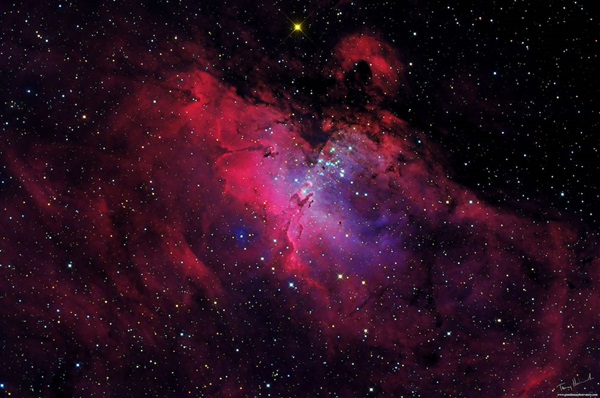Soaring through the summer Milky Way is one of the most recognizable nebulae in the entire sky: the Eagle Nebula. When photographed in full, this glowing red cloud of ionized hydrogen mixed with billowing clouds of opaque cosmic dust reminds many of a majestic bird in flight, with a wingspan extending across 21′.
The Eagle hatched from a star that exploded some 5.5 million years ago. Since then, it has evolved into a productive region of star formation, giving birth to more than 8,000 new stars, according to some estimates.
Many references identify the entire Eagle Nebula as M16 in Charles Messier’s catalog, but that is incorrect. In Messier’s own words, his 16th entry is described as a “cluster of small stars, mingled with a faint glow.” He actually did not see the nebula surrounding the stars, but only the diffuse glow of unresolved stars within the cluster.
Messier’s description of the Eagle mirrors the experience most get using today’s unfiltered backyard telescopes. A 3-inch scope will show some two dozen suns surrounded by a foggy backdrop of fainter, unresolved cluster stars. But add on a narrowband nebula filter and suddenly the Eagle begins to spread its wings. The brightest portions of the nebula surround the cluster, as well as extend to its south.
Bumping up to a telescope with an aperture of 10 inches also increases the size and improves the shape of the Eagle. From a dark-sky site, the cloud’s shape becomes even more reminiscent of its nickname. The brightest portion, adorned with several dozen cluster stars, forms the eagle’s hook-shaped head facing northwest. Fainter portions to the south form its body and extended wings.
The Eagle Nebula gained true stardom in 1995, when the Space Telescope Science Institute released a Hubble image named the Pillars of Creation. That iconic image, one of the orbiting observatory’s most famous, shows three elephant trunks composed of cold molecular hydrogen and dust reaching outward from the Eagle Nebula. Ultraviolet radiation from nearby hot stars is gradually eroding the towering columns. As the pillars slowly erode, small globules of even denser gas and dust are revealed. These are known as evaporating gaseous globules, or EGGs. Eventually, most of these EGGs will go on to hatch into mature stars.
Make sure to explore Astronomy’s full list of 101 cosmic objects you must see. New entries will be added each week throughout 2022.
To get the latest astronomical news and observing content delivered directly to your door, subscribe to Astronomy magazine today!










